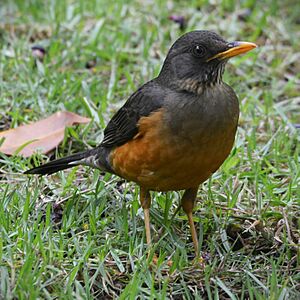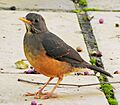Olive thrush facts for kids
Quick facts for kids Olive thrush |
|
|---|---|
 |
|
| Olive thrush adult, Greyton, South Africa | |
| Conservation status | |
| Scientific classification | |
| Genus: |
Turdus
|
| Species: |
olivaceus
|
The olive thrush (Turdus olivaceus) is a very common bird found in parts of Africa. It belongs to the thrush family, called Turdidae. You can find these birds in the highlands of Africa, from southern Malawi and Mozambique all the way down to the Cape of Good Hope in South Africa.
Olive thrushes usually live in forests and woodlands. However, they have also learned to live in parks and big gardens in towns and cities. This makes them easier to spot!
Contents
What is an Olive Thrush?
Physical Features of the Olive Thrush
The olive thrush can grow to about 24 centimeters (about 9.5 inches) long. It can weigh at least 101 grams (about 3.5 ounces). Its tail and upper body are a dull olive-brown color. The belly is white, and the rest of its underside has an orange tint. You might also notice white spots on its throat.
What Does the Olive Thrush Sound Like?
Male olive thrushes have a special song. It's a mix of flute-like sounds, whistles, and trills. Their songs can sound a bit different depending on where they live. Sometimes, they even copy the sounds of other birds!
Where Do Olive Thrushes Live?
Olive thrushes prefer to live in evergreen forests. These are forests where trees stay green all year round. They also live in parks and gardens, especially those with lots of trees and plants.
How Do Olive Thrushes Reproduce?
Building a Nest
The female olive thrush builds a cup-shaped nest. She usually places it in a tree or a hedge, about 2 to 9 meters (6.5 to 30 feet) above the ground.
Eggs and Chicks
Female olive thrushes usually lay 1 to 3 eggs, but most often they lay 2. The female is the only one who sits on the eggs to keep them warm. This is called incubation. It takes about 14 to 15 days for the eggs to hatch. After the chicks hatch, they stay in the nest for another 16 days before they are ready to fly. This is called fledging.
What Do Olive Thrushes Eat?
Olive thrushes have a varied diet. They enjoy eating earthworms, insects, and snails. They also like to snack on fruits and spiders.
Images for kids
-
A young olive thrush near Cape Town, South Africa.




